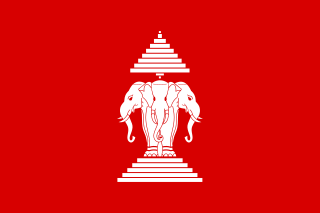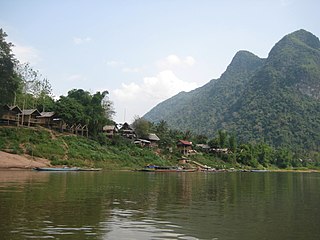Related Research Articles

Laos, officially the Lao People's Democratic Republic, is the only landlocked country in Southeast Asia. At the heart of the Indochinese Peninsula, Laos is bordered by Myanmar and China to the northwest, Vietnam to the east, Cambodia to the southeast, and Thailand to the west and southwest. Its capital and largest city is Vientiane.

The Kingdom of Laos was a landlocked country in Southeast Asia at the heart of the Indochinese Peninsula. It was bordered by Burma and China to the northwest, North Vietnam to the east, Cambodia to the southeast, and Thailand to the west and southwest. The country was governed as a constitutional monarchy that ruled Laos beginning with its independence on 9 November 1953. It survived until December 1975, when its last king, Sisavang Vatthana, surrendered the throne to the Pathet Lao during the civil war in Laos, who abolished the monarchy in favour of a Marxist–Leninist state called the Lao People's Democratic Republic, which has controlled Laos ever since.

The Pathet Lao, officially the Lao People's Liberation Army, was a communist political movement and organization in Laos, formed in the mid-20th century. The group ultimately conquered the entire country in 1975, after the Laotian Civil War. The Pathet Lao were always closely associated with Vietnamese communists and North Vietnam. During the civil war, it was effectively organized, equipped and even led by the People's Army of Vietnam (PAVN). They fought against the anti-communist forces in the Vietnam War. Eventually, the term became the generic name for Laotian communists.

Phoumi Vongvichit was a leading figure of the Pathet Lao and an elder statesman of the Lao People's Democratic Republic.

The Laotian Civil War (1959–1975) was a civil war in Laos waged between the Communist Pathet Lao and the Royal Lao Government from 23 May 1959 to 2 December 1975. It is associated with the Cambodian Civil War and the Vietnam War, with both sides receiving heavy external support in a proxy war between the global Cold War superpowers. It is known as the Secret War among the American CIA Special Activities Center, and Hmong and Mien veterans of the conflict.

Nakhon Phanom province is one of Thailand's seventy-six provinces (changwat) lies in upper northeastern Thailand also called Isan. Directly adjacent provinces are : Mukdahan, Sakon Nakhon, and Bueng Kan. To the northeast it borders Khammouan of Laos.

This article details the history of Laos from 1945 to the present.

Xam Neua, is the capital of Houaphanh Province, Laos, in northeast Laos.
The International Agreement on the Neutrality of Laos is an international agreement signed in Geneva on July 23, 1962 between 14 states, including Laos, as a result of the International Conference on the Settlement of the Laotian Question, which lasted from May 16, 1961 to July 23, 1962.

The Battle of Lima Site 85, also called Battle of Phou Pha Thi, was fought as part of a military campaign waged during the Vietnam War and Laotian Civil War by the North Vietnamese People's Army of Vietnam (PAVN) and the Pathet Lao, against airmen of the United States Air Force (USAF)'s 1st Combat Evaluation Group, elements of the Royal Lao Army, Royal Thai Border Patrol Police, and the Central Intelligence Agency–led Hmong Clandestine Army. The battle was fought on Phou Pha Thi mountain in Houaphanh Province, Laos, on 10 March 1968, and derives its name from the mountaintop where it was fought or from the designation of a 700 feet (210 m) landing strip in the valley below, and was the largest single ground combat loss of United States Air Force members during the Vietnam War.

Operation Barrel Roll was a covert U.S. Air Force 2nd Air Division and U.S. Navy Task Force 77, interdiction and close air support campaign conducted in the Kingdom of Laos between 14 December 1964 and 29 March 1973 concurrent with the Vietnam War. The operation resulted in 260 million bombs being dropped on Laos.
CIA activities in Laos started in the 1950s. In 1959, U.S. Special Operations Forces began to train some Laotian soldiers in unconventional warfare techniques as early as the fall of 1959 under the code name "Erawan". Under this code name, General Vang Pao, who served the royal Lao family, recruited and trained his Hmong and Iu-Mien soldiers. The Hmong and Iu-Mien were targeted as allies after President John F. Kennedy, who refused to send more American soldiers to battle in Southeast Asia, took office. Instead, he called the CIA to use its tribal forces in Laos and "make every possible effort to launch guerrilla operations in North Vietnam with its Asian recruits." General Vang Pao then recruited and trained his Hmong soldiers to ally with the CIA and fight against North Vietnam. The CIA itself claims that the CIA air operations in Laos from 1955 to 1974 were the "largest paramilitary operations ever undertaken by the CIA."

North Vietnam supported the Pathet Lao to fight against the Kingdom of Laos between 1958 and 1959. Control over Laos allowed for the eventual construction of the Ho Chi Minh Trail that would serve as the main supply route for enhanced NLF and NVA activities in the Republic of Vietnam. As such, the support for Pathet Lao to fight against Kingdom of Laos by North Vietnam would prove decisive in the eventual communist victory over South Vietnam in 1975 as the South Vietnamese and American forces could have prevented any NVA and NLF deployment and resupply if these only happened over the 17th Parallel, also known as the Demilitarized Zone (DMZ), a narrow strip of land between North and South Vietnam that was closely guarded by both sides. It also helped the Pathet Lao win against the Kingdom of Laos, even though the Kingdom of Laos had American support.
The Military history of Laos has been dominated by struggles against stronger neighbours, primarily Thailand and Vietnam, from at least the 18th century.

Muang Ngoi Neua is a Lao town along the Nam Ou in Louangphrabang Province. It is part of Ngoi district 170 kilometres North-East of Luang Prabang.

Houaphanh province is a province in eastern Laos. Its capital is Xam Neua.
The raid onBan Naden of 9 January 1967 was a successful rescue of prisoners of war during the Vietnam War. The raid was improvised after local Central Intelligence Agency officers induced a Pathet Lao deserter to lead a rescue party back to the prison camp. At about 0400 hours on 9 January 1967, a raiding party of 10 Lao mercenaries led by Sergeant Te killed or dispersed the communist guard force, only to discover twice as many rescuees as they had counted upon. Some of the captives immediately returned to their local homes, while the others followed their rescuers to an impromptu pickup zone in the midst of the Ho Chi Minh Trail. Hastily summoned Air America helicopters retrieved the raiders and the remaining prisoners, one of whom was Phisit Intharathat.
Operation Junction City Jr. was a major Laotian offensive of the Vietnam War; initially aimed at temporary disruption of the Ho Chi Minh Trail, it was extended into an attempt to isolate the major North Vietnamese communist transshipment point at Tchepone from the units it was supposed to supply.
Campaign 139 was a major military offensive of the People's Army of Vietnam, launched against its Royalist enemies during the Laotian Civil War. Larger than previous invading forces, Campaign 139 was also a combined arms expedition containing tanks, artillery, engineers, and Dac Cong sappers. As such, it was a decided escalation in the war. It was also an exceptional rainy season offensive by PAVN, which usually withdrew during the wet season.
Campaign 972 was the final offensive in the south of the Kingdom of Laos by the People's Army of Vietnam (PAVN). After fending off a score of Royal Lao Government attacks against the Ho Chi Minh Trail between June 1969 and late 1972, the PAVN attacked and essentially cut Laos in two at Khong Sedone by November 1972. Sporadic ongoing fighting, especially for control of Paksong, continued until 8 February 1973. Although a ceasefire officially ended the Laotian Civil War at noon on 23 February with Salavan, Thakhek, and Lao Ngam in Communist hands, the PAVN launched another successful assault on Paksong 15 minutes later.
References
- ↑ Martin Stuart-Fox: Historical Dictionary of Laos, Scarecrow Press 2001
- ↑ The Secret War in Viengxay: A background paper by Dr Paul Rogers http://www.scottasia.net/viengxay/downloads/The%20Secret%20War%20in%20Viengxay.pdf Archived 2010-12-26 at the Wayback Machine
- ↑ Laos Opens Wartime 'Cave City' to Visitors